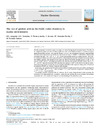Identificador persistente para citar o vincular este elemento:
https://accedacris.ulpgc.es/jspui/handle/10553/108004
| Campo DC | Valor | idioma |
|---|---|---|
| dc.contributor.author | Arreguin, M.L. | en_US |
| dc.contributor.author | González González, Aridane | en_US |
| dc.contributor.author | Pérez Almeida, María Norma | en_US |
| dc.contributor.author | Arnone, Veronica | en_US |
| dc.contributor.author | González Dávila, Melchor | en_US |
| dc.contributor.author | Santana Casiano, Juana Magdalena | en_US |
| dc.date.accessioned | 2021-06-25T10:27:03Z | - |
| dc.date.available | 2021-06-25T10:27:03Z | - |
| dc.date.issued | 2021 | en_US |
| dc.identifier.issn | 0304-4203 | en_US |
| dc.identifier.uri | https://accedacris.ulpgc.es/handle/10553/108004 | - |
| dc.description.abstract | Phenolic compounds excreted by marine microalgae are part of the ligand pool in natural waters. The effect of the polyphenol gentisic acid (GA; 2,5 dihydroxybenzoic acid) on the Fe(III) reduction as a function of organic ligand concentration (100 nM – 1000 nM) and the pH (7.00–8.01) was investigated in seawater. Major seawater ions interactions with both GA and Fe(III) were also considered using 0.7 M NaCl +2 mM NaHCO3 solutions with each major ions (Mg2+, Ca2+, SO42−, K+, F−, Sr2+) at the same ratio than that in a 35 salinity seawater. The Fe(III)-GA complex in solution was able to produce Fe(II) in a pH-dependent process that was faster in seawater than in NaCl-NaHCO3 solution. The addition of each major ion affected the Fe(III) reduction process. At pH 7.5, the presence of Mg2+ and Ca2+ contributes to accelerate the reduction rate constant of Fe(III) to Fe(II). The K+, F−, Sr2+, and SO42− ions slow down the Fe(III) reduction rate constant. At pH 7.8, the effect of the ions is counteracted. Increasing the pH to 8, the effect on the solubility of Fe(III) is more important, being greater in NaCl and no reduction of Fe(III) was detected, compared with seawater. In this study, the formation and dissociation of the Fe(III)-GA complex in seawater was studied, resulting in kf = 1.19(±0.18)•104 (M−1 s−1), kd = 1.86 (±0.53)•10−4 (s−1), and conditional complexation constant of logKFe3+LCond = 17.81 ± 0.05 in seawater. Accordingly, phenolic compounds like GA influence the Fe marine biogeochemical cycles promoting the formation of the bioavailable Fe(II) in solution. Taking this into account, the Fe(III) reactions with phenolic compounds have to be considered to improve our understanding of the global iron cycle. | en_US |
| dc.language | eng | en_US |
| dc.relation | Efecto de la Acidificacion Oceanica, la Temperatura y El Contenido de Materia Organica en la Persistencia de Fe(Ii) en El Oceano Atlantico | en_US |
| dc.relation.ispartof | Marine Chemistry | en_US |
| dc.source | Marine Chemistry [ISSN 0304-4203], v. 234, 104003 (Agosto 2021) | en_US |
| dc.subject | 251002 Oceanografía química | en_US |
| dc.subject.other | Iron | en_US |
| dc.subject.other | Gentisic acid | en_US |
| dc.subject.other | Kinetics | en_US |
| dc.subject.other | Seawater | en_US |
| dc.subject.other | Complexation | en_US |
| dc.title | The role of gentisic acid on the Fe(III) redox chemistry in marine environments | en_US |
| dc.type | info:eu-repo/semantics/Article | en_US |
| dc.type | article | en_US |
| dc.identifier.doi | 10.1016/j.marchem.2021.104003 | en_US |
| dc.relation.volume | 234 | en_US |
| dc.investigacion | Ciencias | en_US |
| dc.type2 | Artículo | en_US |
| dc.description.numberofpages | 10 | en_US |
| dc.utils.revision | Sí | en_US |
| dc.date.coverdate | Agosto 2021 | en_US |
| dc.identifier.ulpgc | Sí | en_US |
| dc.contributor.buulpgc | BU-BAS | en_US |
| dc.description.sjr | 1,272 | |
| dc.description.jcr | 3,994 | |
| dc.description.sjrq | Q1 | |
| dc.description.jcrq | Q1 | |
| dc.description.scie | SCIE | |
| dc.description.miaricds | 11,0 | |
| item.grantfulltext | open | - |
| item.fulltext | Con texto completo | - |
| crisitem.author.dept | GIR IOCAG: Química Marina | - |
| crisitem.author.dept | IU de Oceanografía y Cambio Global | - |
| crisitem.author.dept | Departamento de Química | - |
| crisitem.author.dept | GIR IOCAG: Química Marina | - |
| crisitem.author.dept | IU de Oceanografía y Cambio Global | - |
| crisitem.author.dept | Departamento de Química | - |
| crisitem.author.dept | GIR IOCAG: Química Marina | - |
| crisitem.author.dept | IU de Oceanografía y Cambio Global | - |
| crisitem.author.dept | GIR IOCAG: Química Marina | - |
| crisitem.author.dept | IU de Oceanografía y Cambio Global | - |
| crisitem.author.dept | Departamento de Química | - |
| crisitem.author.dept | GIR IOCAG: Química Marina | - |
| crisitem.author.dept | IU de Oceanografía y Cambio Global | - |
| crisitem.author.dept | Departamento de Química | - |
| crisitem.author.orcid | 0000-0002-5637-8841 | - |
| crisitem.author.orcid | 0000-0002-9044-3758 | - |
| crisitem.author.orcid | 0000-0002-8044-0350 | - |
| crisitem.author.orcid | 0000-0003-3230-8985 | - |
| crisitem.author.orcid | 0000-0002-7930-7683 | - |
| crisitem.author.parentorg | IU de Oceanografía y Cambio Global | - |
| crisitem.author.parentorg | IU de Oceanografía y Cambio Global | - |
| crisitem.author.parentorg | IU de Oceanografía y Cambio Global | - |
| crisitem.author.parentorg | IU de Oceanografía y Cambio Global | - |
| crisitem.author.parentorg | IU de Oceanografía y Cambio Global | - |
| crisitem.author.fullName | González González, Aridane | - |
| crisitem.author.fullName | Pérez Almeida, María Norma | - |
| crisitem.author.fullName | Arnone,Veronica | - |
| crisitem.author.fullName | González Dávila, Melchor | - |
| crisitem.author.fullName | Santana Casiano, Juana Magdalena | - |
| crisitem.project.principalinvestigator | Santana Casiano, Juana Magdalena | - |
| Colección: | Artículos | |
Visitas
164
actualizado el 05-oct-2024
Descargas
184
actualizado el 05-oct-2024
Google ScholarTM
Verifica
Altmetric
Comparte
Exporta metadatos
Los elementos en ULPGC accedaCRIS están protegidos por derechos de autor con todos los derechos reservados, a menos que se indique lo contrario.
